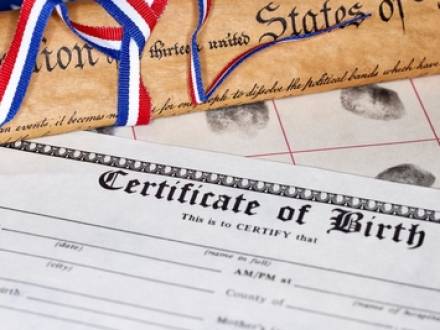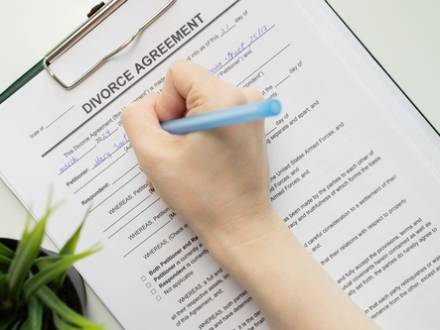Recent Blog Posts
Can a Father Refuse to Sign the Birth Certificate to Get Out of Child Support?
 In Illinois, both parents have a legal responsibility to support their children. Child support is meant to make sure that a child’s needs are met, whether or not the parents are married or living together. Many fathers have questions about when support payments begin. They may also wonder how paternity is established, and whether they can avoid having to pay child support if they do not sign the birth certificate.
In Illinois, both parents have a legal responsibility to support their children. Child support is meant to make sure that a child’s needs are met, whether or not the parents are married or living together. Many fathers have questions about when support payments begin. They may also wonder how paternity is established, and whether they can avoid having to pay child support if they do not sign the birth certificate.
The short answer is no. Refusing to sign a birth certificate does not mean a biological father does not have to pay child support. Illinois law gives children the right to financial support from both parents, and that right cannot be waived because one parent does not want to pay or to claim the child.
At Goostree Law Group, our Kane County family law attorneys help clients navigate tough questions of paternity, custody, and support. With decades of combined experience, we know how to protect both your rights and your child’s best interests.
Should You File for Divorce Together or Separately?
 When a marriage ends, many couples find themselves wondering how exactly they should begin the divorce process. In Illinois, divorce begins with the filing of a petition for dissolution of marriage. Some people ask whether they should file for divorce together with their spouse, as a "joint action," or if one spouse should file separately. The answer depends on your situation, your ability to work together, and what you want the process to look like.
When a marriage ends, many couples find themselves wondering how exactly they should begin the divorce process. In Illinois, divorce begins with the filing of a petition for dissolution of marriage. Some people ask whether they should file for divorce together with their spouse, as a "joint action," or if one spouse should file separately. The answer depends on your situation, your ability to work together, and what you want the process to look like.
Deciding how to file is an important step that can affect everything from how much a divorce costs to how long it takes. Since Illinois family law has changed a lot in recent years, especially after major changes in 2016, understanding your options can help you start on the right foot. Call our Wheaton, IL divorce lawyers today to learn which type of filing is right for you.
Are Arranged Marriages More or Less Likely to End in Divorce?
 Depending on your cultural background, the idea of an arranged marriage might feel outdated, unfamiliar, or even surprising. However, for some, arranged marriages are a completely normal, respected, and even expected tradition. While it may seem like an old-world concept in the United States, arranged marriages remain common across the world. Divorce statistics from these marriages raise important questions about stability and expectations in marriage.
Depending on your cultural background, the idea of an arranged marriage might feel outdated, unfamiliar, or even surprising. However, for some, arranged marriages are a completely normal, respected, and even expected tradition. While it may seem like an old-world concept in the United States, arranged marriages remain common across the world. Divorce statistics from these marriages raise important questions about stability and expectations in marriage.
Sometimes, people who come from cultures that do not have arranged marriages idealize the idea of having a partner chosen for you by the people who know you best. The truth is, whatever strategy you use to get married, a happy marriage is no guarantee. If you are living in Illinois and are thinking about divorce, you may be wondering whether the statistics on arranged marriages have anything to say about your own situation. Getting to the bottom of how many arranged marriages last is more complicated than just looking at the numbers.
What is Sole Custody and is it Possible in Illinois?
 Parents facing divorce or separation in Illinois hear terms like "custody," "parenting time," and "decision-making responsibilities." These phrases carry enormous weight, because they determine how a child will be raised and how much influence each parent will have in that process. One question that parents often have is whether sole custody is possible in Illinois and, if so, what it means in practice.
Parents facing divorce or separation in Illinois hear terms like "custody," "parenting time," and "decision-making responsibilities." These phrases carry enormous weight, because they determine how a child will be raised and how much influence each parent will have in that process. One question that parents often have is whether sole custody is possible in Illinois and, if so, what it means in practice.
As of September 2025, Illinois family law continues to use the relatively new term of "allocation of parental responsibilities" in the Illinois Marriage and Dissolution of Marriage Act (750 ILCS 5/600). While the word "custody" is still used in everyday conversation, Illinois law now divides this larger topic into two key categories: parenting time and decision-making. Sole custody is possible, but it looks different under modern law than many parents expect.
Is Child Support Taxable or Tax Deductible?
 Divorce and legal separation create several financial questions, especially when adults have minor children. Parents not only need to work out their parenting time and decision-making arrangements, but also how they will handle the costs of raising a child once their marriage ends. Child support is an important tool for ensuring that children are cared for, but it often raises another question: How will it affect your taxes?
Divorce and legal separation create several financial questions, especially when adults have minor children. Parents not only need to work out their parenting time and decision-making arrangements, but also how they will handle the costs of raising a child once their marriage ends. Child support is an important tool for ensuring that children are cared for, but it often raises another question: How will it affect your taxes?
The short answer is thankfully straightforward: Child support is not taxable income for the parent receiving it, and it is not tax deductible for the parent paying it. But while the rule itself is simple, the reality of how child support interacts with taxes, income, and other financial factors can be more complicated.
At Goostree Law Group, our Wheaton child support attorneys bring decades of combined experience, including service as judges, appellate court attorneys, and in private practice, to help Illinois families understand the full financial impact of child support. We offer free consultations to discuss your case.
Alimony Myths - Getting the Facts Straight in Illinois
 Alimony, also called spousal maintenance or spousal support, is one of the most misunderstood parts of divorce law. Many people enter the process believing myths that can cloud judgment and create false expectations. In Illinois, alimony is governed by 750 ILCS 5/504 of the Illinois Marriage and Dissolution of Marriage Act, and the rules are far more structured than many realize.
Alimony, also called spousal maintenance or spousal support, is one of the most misunderstood parts of divorce law. Many people enter the process believing myths that can cloud judgment and create false expectations. In Illinois, alimony is governed by 750 ILCS 5/504 of the Illinois Marriage and Dissolution of Marriage Act, and the rules are far more structured than many realize.
As of August 2025, Illinois still uses statutory formulas to calculate maintenance in most cases, but judges also have discretion to depart from those guidelines if unique circumstances require it. Understanding how the law really works can help divorcing spouses make better decisions, especially as they begin preparing for divorce.
If you are thinking about getting divorced and have questions about how alimony might apply to your case, call our Kendall County, IL divorce attorneys and schedule a free initial consultation.
What Does a Forensic Accountant Do in a Divorce?
 Divorces involving complex finances can be highly contested and involve multiple appearances in court. One of the most difficult challenges in these cases is understanding what the marital estate is truly worth. Assets may include multiple properties, business interests, investment accounts, retirement plans, and sometimes hidden funds that one spouse would prefer to keep off the books. In these cases, our Wheaton divorce attorneys often recommend working with a forensic accountant.
Divorces involving complex finances can be highly contested and involve multiple appearances in court. One of the most difficult challenges in these cases is understanding what the marital estate is truly worth. Assets may include multiple properties, business interests, investment accounts, retirement plans, and sometimes hidden funds that one spouse would prefer to keep off the books. In these cases, our Wheaton divorce attorneys often recommend working with a forensic accountant.
A forensic accountant is a financial professional trained to investigate, analyze, and testify about complicated financial matters. In divorce, they play a critical role in uncovering hidden assets, valuing businesses, and ensuring that property is divided fairly under Illinois law. With decades of combined experience, our firm routinely works alongside forensic accountants and other experts to protect clients’ interests in high-stakes divorces.
Update: Seven Reasons Your Divorce Agreement Can Be Rejected in Court
 Negotiating the terms of your divorce can be an exhausting process. By the time you and your spouse have agreed on property division, parenting time, and support, you may feel relieved and ready to move forward with your life. But even if both of you sign the agreement, the court still has the final say.
Negotiating the terms of your divorce can be an exhausting process. By the time you and your spouse have agreed on property division, parenting time, and support, you may feel relieved and ready to move forward with your life. But even if both of you sign the agreement, the court still has the final say.
In Illinois, a divorce agreement is a binding contract between spouses, but it must meet specific legal standards before a judge will approve it. If the court finds that your agreement violates the law, is fundamentally unfair, or was reached improperly, it can be rejected. That could send you back to the negotiating table and delay your divorce.
As of August 2025, Illinois courts still review divorce settlement agreements under the Illinois Marriage and Dissolution of Marriage Act (750 ILCS 5). The judge’s role is to ensure the agreement complies with the law and serves the best interests of any children involved. At Goostree Law Group, our job is to make sure your settlement is strong and will be approved before it even reaches the judge. Here are seven common reasons an agreement can be denied, and how to avoid them. Call our Kane County, IL divorce attorneys to learn more.
Child Custody Schedules By Age in Illinois
 Parents navigating divorce or separation in Wheaton or elsewhere in DuPage County are often most concerned about how much time they will have with their children. In Illinois, there is no "standard" custody schedule. Instead, courts and attorneys focus on crafting a parenting time plan that fits the child’s age, developmental stage, and emotional needs.
Parents navigating divorce or separation in Wheaton or elsewhere in DuPage County are often most concerned about how much time they will have with their children. In Illinois, there is no "standard" custody schedule. Instead, courts and attorneys focus on crafting a parenting time plan that fits the child’s age, developmental stage, and emotional needs.
Goostree Law Group has decades of combined experience serving Illinois families, and we understand that custody arrangements are not simply about dividing days on a calendar; they are about helping children thrive after a major life transition.
We are deeply involved in community service and pro bono efforts, and that commitment to people is reflected in how we approach each case.
Illinois Parenting Time Law and the Best Interests Standard
Under the Illinois Marriage and Dissolution of Marriage Act, child custody is formally called "the allocation of parental responsibilities," and parenting time refers to the physical time each parent spends with the child. Judges do not begin with a default schedule. Instead, they consider what is in the best interests of the child based on a long list of statutory factors. One of the most important of these is the child’s age.
Orders of Protection in Illinois
 Filing for an Order of Protection can be a critical step towards a better life for someone experiencing abuse, harassment, or serious threats. In Illinois, these legal orders offer protection from physical harm, stalking, intimidation, and interference with personal freedom. But they are not one-size-fits-all, and although they do provide protection in most circumstances, they also come with legal, emotional, and safety considerations.
Filing for an Order of Protection can be a critical step towards a better life for someone experiencing abuse, harassment, or serious threats. In Illinois, these legal orders offer protection from physical harm, stalking, intimidation, and interference with personal freedom. But they are not one-size-fits-all, and although they do provide protection in most circumstances, they also come with legal, emotional, and safety considerations.
Whether you need to protect yourself and your children, or are defending against a wrongful accusation in a heated custody or divorce case, it is important to understand how Orders of Protection work under current Illinois law. A St. Charles, IL order of protection attorney at Goostree Law Group can help you take the next steps with clarity and caution.
What Is an Illinois Order of Protection Exactly?
An Order of Protection is a court-issued order that restricts the behavior of someone who has allegedly committed abuse or posed a threat. The person asking for the order is called the petitioner. The person the order is filed against is the respondent. In Illinois, Orders of Protection are governed by the Illinois Domestic Violence Act (750 ILCS 60).












